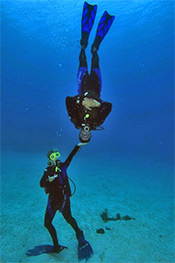
Photo source: http://www.diversinc.com
Of all the skills a diver learns, achieving neutral buoyancy stands out in terms of safety and enjoyment of the sport, and keeps damage to the reef system to a minimum. But, how do you make the transition from “just getting down” to zen-like buoyancy control?
Well, first you commit to it. This may seem obvious but think about it. For most, diving is an occasional thing. Opportunities to dive are often limited to vacations, so months (or years) often pass between dives. When you get on a dive boat, the divemaster will often ask, “how much weight do you need?”
If it’s been a while, how do you know? Did you ever really know. Most likely, you take a guess and if you manage to get to the bottom and stay there, good enough. For a lot of divers, there is a bit of an intimidation factor on a dive boat. No one wants to be the one to stand out, let alone hold things up with a proper buoyancy check.
The result is almost always drastic over-weighting among divers. At best this makes diving uncomfortable, and at worst, dangerous–to say nothing of the potential for environmental damage.
In my thousands of boat dives spanning decades, I have never seen a diver do a buoyancy check. I can only think of one or two times that I’ve seen a dive make a weighting adjustment between dives. Yet, I see divers bounce off the bottom on just about every dive.
Next time you’re on a boat, ask if you can take a minute before the dive to get your buoyancy adjusted. I guarantee the divemaster will be delighted. They are there to help ensure your enjoyment and safety, and certainly don’t want their reef systems damaged.
Chances are, you’ll have half the people on the boat asking to do the same, and everyone will be a better diver for it.

